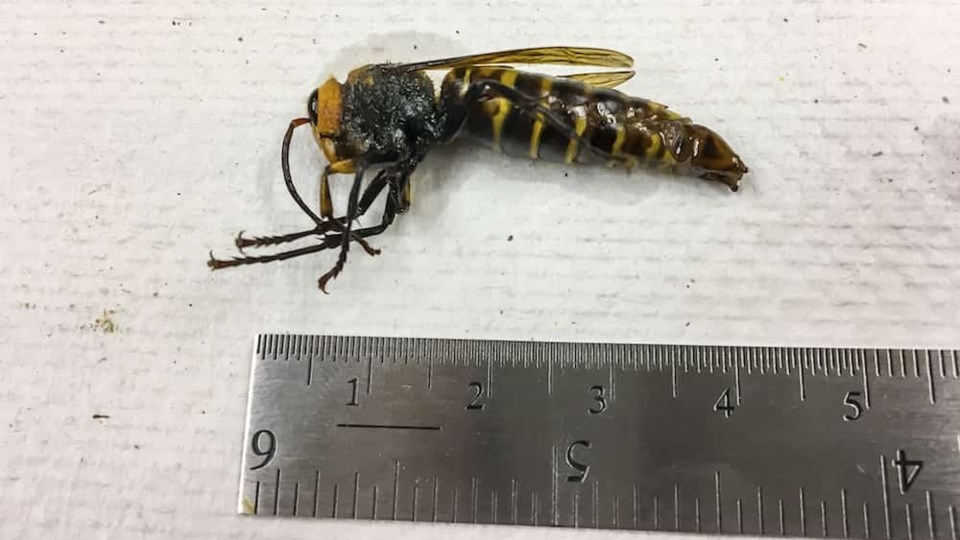The Washington State Department of Agriculture (WSDA) says it has trapped a male Asian giant hornet, which is the first male Asian giant hornet to be detected in the United States.
According to a press release, the WSDA states that the hornet was caught in one of its Asian giant hornet bottle traps near Custer, Whatcom County. The department notes that a mated queen was found dead earlier this year in the same location and a suspected bee kill was reported in 2019. The trap was collected on July 29 and processed in WSDA’s entomology lab on August 13.
“Trapping a male Asian giant hornet in July initially came as a surprise,” Sven Spichiger, WSDA managing entomologist said. “But further examination of the research and consultation with international experts confirmed that a few males can indeed emerge early in the season.”
To try and trap a live Asian giant hornet, the WSDA will be setting live traps in the area. If they catch one, they will then tag it, and track it back to its nest. If they find a nest, the agency will eradicate it.
This is the second Asian giant hornet caught in a WSDA trap. The first was caught on July 14. Entomologists from the U.S. Department of Agriculture Animal and Plant Health Inspection Service (USDA APHIS) subsequently identified that hornet as an unmated queen. The two trapped specimens bring the total number of Asian giant hornets detected in the state to seven – all of them in Whatcom County.
With a wingspan of four to seven centimetres, as well as a potent sting that purportedly feels like a 'red-hot thumbtack,' it is no wonder why locals fear the spread of the Asian Giant Hornet.
An invasive species, the Asian Giant Hornet (Vespa mandarinia), is commonly referred to as the 'murder hornet.' Normally found in the forests and low mountains of eastern and southeast Asia, it remains unclear how they arrived in North America. Their moniker — perhaps better suited for a comic book title or rock band name — was coined in Japan.
Three Asian giant hornets were spotted in B.C. for the first time last August in the Nanaimo area, the province’s agriculture ministry said. The single nest was spotted and destroyed, but a specimen was found last November in White Rock and two specimens were found in December at Blaine, Washington
In May, Provincial Apiculturist Paul Van Westendorp stated that a specimen had been identified and collected in the Fraser Valley.
VanWestendorp said the latest find indicates that the hornets may have established nests farther into the Fraser Valley than had been anticipated.
Scott Gordon, Apiary Inspector for the Lower Mainland, told Vancouver Is Awesome in a phone call that a nest was found on Vancouver Island. However, no nests have been found in the province since - and inspectors have been looking for them. People are also encouraged to contact the Invasive Species Council if they think they've spotted an individual or nest.
Gordon added that hornet populations start small and grow through the summer season, because Asian giant hornet workers increase as a colony develops. As such, they are most likely seen in August and September.
Disturbing a nest, however, will put them on the attack. And a sting packs a mighty wallop.
A Vancouver island man says the sting felts as though hot thumbtacks had been stuck into his leg. Further, he experienced “throbbing muscular aches” in the legs for about 24 hours.
The buzz about Asian giant hornets
• If you find a nest, do not disturb it. Leave the area.
• Stings are rare but could occur if the nest is disturbed.
• Because of the larger amount of venom injected, a sting can be very painful and cause localized swelling, redness and itching.
• Treat a sting similar to wasp or bee stings by putting ice or a cold compress on the site to reduce inflammation and spread of venom.
• Do not rub the site because it will spread venom.
• People who are stung multiple times (10 or more) have a higher risk of developing toxic or allergic reactions, lightheadedness or dizziness.
• People who are stung multiple time or who develop symptoms of toxic or allergic reactions are advised to seek medical attention immediately.
• If you think you’ve spotted an Asian giant hornet, call the Invasive Species Council of B.C. at 1-888-933-3722, or via the council’s “Report Invasives” mobile phone app, or online HERE.
- With files from Carla Wilson / The Times Colonist and The Canadian Press.
This article was originally published by Vancouver Is Awesome.




